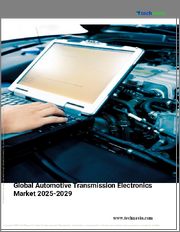
|
시장보고서
상품코드
1610676
자동차 일렉트로닉스 시장 규모, 점유율, 성장 분석 : 컴포넌트별, 차종별, 추진별, 판매채널별, 지역별 - 산업 예측(2024-2031년)Automotive Electronics Market Size, Share, Growth Analysis, By Component (Electronic Control Unit (ECU), Sensors), By Vehicle Type, By Propulsion, By Sales Channel, By Region - Industry Forecast 2024-2031 |
||||||
세계의 자동차 일렉트로닉스 시장 규모는 2022년에 2,345억 7,000만 달러로 평가되며, 2023년 2,554억 5,000만 달러에서 2031년에는 5,052억 7,000만 달러로 성장하며, 예측 기간(2024-2031년)의 CAGR은 8.9%로 성장할 전망입니다.
자동차 산업은 주로 승용차와 소형 트럭을 중심으로 차체, 엔진 등 부품 생산에 이르기까지 자동차 생산의 모든 측면을 아우르는 산업입니다. 주요 시장 성장 촉진요인으로는 IoT와 AI 기술의 통합, 자율주행차에 대한 수요 증가, 차량내 안전 기능의 중요성, 엔터테인먼트 시스템 강화 등이 있습니다. 그러나 신흥 시장에서의 자동차 전자장비 채택 지연과 관련 기술 관련 비용 상승 등 과제도 남아있습니다. 이러한 장애물에도 불구하고 자동차용 일렉트로닉스 부문은 자율주행차 기술 진화를 위한 스마트 그리드에 대한 투자를 통해 큰 이익을 얻을 수 있으며, 시장 점유율을 높이고 업계내 혁신을 촉진할 수 있을 것으로 기대됩니다.
목차
서론
- 조사의 목적
- 조사 범위
- 정의
조사 방법
- 정보 조달
- 2차 데이터와 1차 데이터 방법
- 시장 규모 예측
- 시장의 전제조건과 제한
개요
- 세계 시장 전망
- 공급과 수요 동향 분석
- 부문별 기회 분석
시장 역학과 전망
- 시장 개요
- 시장 규모
- 시장 역학
- 촉진요인과 기회
- 억제요인과 과제
- Porter의 산업 분석과 영향
- 경쟁 기업 간 경쟁 관계
- 대체품의 위협
- 바이어의 교섭력
- 신규 진출업체의 위협
- 공급 기업의 교섭력
주요 시장 인사이트
- 주요 성공 요인
- 경쟁의 정도
- 주요 투자 기회
- 시장 에코시스템
- 시장의 매력 지수(2023년)
- PESTEL 분석
- 거시경제 지표
- 밸류체인 분석
- 가격 분석
- 규제 상황
- 특허 분석
- 사례 연구
자동차 일렉트로닉스 시장 규모 : 컴포넌트별 & CAGR(2024-2031)
- 시장 개요
- 전자 제어 유닛(ECU)
- 센서
- Current Carrying Devices
- 기타
자동차 일렉트로닉스 시장 규모 : 차종별 & CAGR(2024-2031)
- 시장 개요
- 승용차
- 상용차
자동차 일렉트로닉스 시장 규모 : 추진별 & CAGR(2024-2031)
- 시장 개요
- 내연기관(ICE)
- 전기자동차(EV)
- 하이브리드차
자동차 일렉트로닉스 시장 규모 : 용도별 & CAGR(2024-2031)
- 시장 개요
- ADAS(첨단운전자보조시스템)
- 어댑티브 크루즈 컨트롤
- 차선이탈 경보
- 자동긴급제동장치
- 보디 일렉트로닉스
- 라이팅
- HVAC 시스템
- 파워 윈도우
- 인포테인먼트와 커뮤니케이션
- 오디오 시스템
- 내비게이션 시스템
- 텔레매틱스
- 파워트레인
- 엔진 제어
- 변속기 컨트롤
- 배터리 관리 시스템
- 안전 시스템
- 에어백
- 안티 락 브레이크 시스템(ABS)
- 전자 안정 제어(ESC)
자동차 일렉트로닉스 시장 규모 : 판매채널별 & CAGR(2024-2031)
- 시장 개요
- OEM(Original Equipment Manufacturer)
- 애프터마켓
자동차 일렉트로닉스 시장 규모 : 지역별 & CAGR(2024-2031)
- 북미
- 미국
- 캐나다
- 유럽
- 영국
- 독일
- 스페인
- 프랑스
- 이탈리아
- 기타 유럽 지역
- 아시아태평양
- 중국
- 인도
- 일본
- 한국
- 기타 아시아태평양
- 라틴아메리카
- 브라질
- 기타 라틴아메리카 지역
- 중동 및 아프리카
- GCC 국가
- 남아프리카공화국
- 기타 중동 및 아프리카
경쟁 정보
- 상위 5사의 비교
- 주요 기업의 시장 포지셔닝(2023년)
- 주요 시장 기업이 채택한 전략
- 시장의 최근 동향
- 기업의 시장 점유율 분석(2023년)
- 주요 기업의 기업 개요
- 회사 개요
- 제품 포트폴리오 분석
- 부문별 점유율 분석
- 매출의 전년대비 비교(2021-2023)
주요 기업 개요
- Robert Bosch GmbH
- Continental AG
- Denso Corporation
- Aptiv PLC
- ZF Friedrichshafen AG
- Hyundai Mobis
- Magna International Inc.
- Autoliv Inc.
- Panasonic Corporation
- Sony Corporation
- Infineon Technologies AG
- NXP Semiconductors
- Texas Instruments Inc.
- Valeo SA
- Harman International Industries, Inc.
- HELLA GmbH & Co. KGaA
- Mitsubishi Electric Corporation
- Hitachi Automotive Systems, Ltd.
- Visteon Corporation
- Lear Corporation
결론과 권장사항
KSA 24.12.19Global Automotive Electronics Market size was valued at USD 234.57 billion in 2022 and is poised to grow from USD 255.45 billion in 2023 to USD 505.27 billion by 2031, growing at a CAGR of 8.9% during the forecast period (2024-2031).
The automotive industry encompasses all facets of motor vehicle production, focusing primarily on passenger cars and light trucks, while also addressing the creation of parts such as bodywork and engines. Key market drivers include the integration of IoT and AI technologies, a growing demand for automated vehicles, increased emphasis on in-vehicle safety features, and enhanced entertainment systems. However, challenges remain, notably the slow adoption of automotive electronics in emerging markets and the escalating costs linked to these technologies. Despite these hurdles, the automotive electronics sector stands to gain significantly from investments in smart grids aimed at advancing autonomous vehicle technology, which is expected to boost market share and foster innovation within the industry.
Top-down and bottom-up approaches were used to estimate and validate the size of the Global Automotive Electronics market and to estimate the size of various other dependent submarkets. The research methodology used to estimate the market size includes the following details: The key players in the market were identified through secondary research, and their market shares in the respective regions were determined through primary and secondary research. This entire procedure includes the study of the annual and financial reports of the top market players and extensive interviews for key insights from industry leaders such as CEOs, VPs, directors, and marketing executives. All percentage shares split, and breakdowns were determined using secondary sources and verified through Primary sources. All possible parameters that affect the markets covered in this research study have been accounted for, viewed in extensive detail, verified through primary research, and analyzed to get the final quantitative and qualitative data.
Global Automotive Electronics Market Segmental Analysis
Global Automotive Electronics Market is segmented by component, vehicle type, propulsion, sales channel and region. Based on component, the market is segmented into electronic control unit (ECU), sensors, current carrying devices and others. Based on vehicle type, the market is segmented into passenger cars and commercial vehicles. Based on propulsion, the market is segmented into internal combustion engine (ICE), electric vehicles (EV) and hybrid vehicles. Based on application, the market is segmented into Advanced Driver Assistance Systems (ADAS), Body Electronics, Infotainment & Communication, Powertrain, Safety Systems. Based on sales channel, the market is segmented into OEM (original equipment manufacturer) and aftermarket. Based on region, the market is segmented into North America, Europe, Asia Pacific, Latin America and Middle East & and Africa.
Driver of the Global Automotive Electronics Market
The global automotive electronics market is poised for significant growth, fueled by the increasing demand for high-tech vehicles and the growing adoption of advanced safety systems aimed at reducing traffic-related fatalities. Stringent government regulations concerning fuel emission standards are also contributing to this momentum. Furthermore, the anticipated transition to sophisticated safety technologies, including alcohol ignition interlocks, emergency call systems, and accident data recording systems, will further enhance market expansion. As fuel consumption concerns rise, the demand for efficient powertrain solutions and fuel injection technology in both passenger and commercial vehicles is expected to grow, prompting automakers to intensify their research and development efforts to innovate solutions that comply with strict low-carbon emission mandates.
Restraints in the Global Automotive Electronics Market
The Global Automotive Electronics market faces significant restraints primarily due to escalating concerns regarding the protection of electronic devices from damage and stringent government regulations aimed at ensuring vehicle safety. These factors have posed substantial challenges to the revenue share within the sector. Furthermore, the high costs associated with maintenance and replacement of automotive electronic components are likely to hinder market growth. The increasing apprehension surrounding the security of technological devices, combined with demanding legislative requirements for auto safety, presents notable obstacles that will constrain the market dynamics, including automotive electronics market share, growth, and trends moving forward.
Market Trends of the Global Automotive Electronics Market
The Global Automotive Electronics market is witnessing significant growth driven by rapid technological advancements and the rise of autonomous and electric vehicles. The proliferation of affordable electric vehicles equipped with sophisticated features is reshaping consumer expectations, thereby increasing demand for advanced automotive electronics. Additionally, the shift towards hybrid and premium vehicles, which often incorporate in-car entertainment and connectivity systems, enhances the user experience. Furthermore, the integration of cutting-edge safety technologies, including parking assistance, electronic braking, and steering systems, is fostering a heightened demand among both manufacturers and consumers, solidifying the market's trajectory towards innovation and enhanced safety in automotive design.
Table of Contents
Introduction
- Objectives of the Study
- Scope of the Report
- Definitions
Research Methodology
- Information Procurement
- Secondary & Primary Data Methods
- Market Size Estimation
- Market Assumptions & Limitations
Executive Summary
- Global Market Outlook
- Supply & Demand Trend Analysis
- Segmental Opportunity Analysis
Market Dynamics & Outlook
- Market Overview
- Market Size
- Market Dynamics
- Driver & Opportunities
- Restraints & Challenges
- Porters Analysis & Impact
- Competitive rivalry
- Threat of substitute
- Bargaining power of buyers
- Threat of new entrants
- Bargaining power of suppliers
Key Market Insights
- Key Success Factors
- Degree of Competition
- Top Investment Pockets
- Market Ecosystem
- Market Attractiveness Index, 2023
- PESTEL Analysis
- Macro-Economic Indicators
- Value Chain Analysis
- Pricing Analysis
- Regulatory Landscape
- Patent Analysis
- Case Studies
Global Automotive Electronics Market Size by Component & CAGR (2024-2031)
- Market Overview
- Electronic Control Unit (ECU)
- Sensors
- Current Carrying Devices
- Others
Global Automotive Electronics Market Size by Vehicle Type & CAGR (2024-2031)
- Market Overview
- Passenger Cars
- Commercial Vehicles
Global Automotive Electronics Market Size by Propulsion & CAGR (2024-2031)
- Market Overview
- Internal Combustion Engine (ICE)
- Electric Vehicles (EV)
- Hybrid Vehicles
Global Automotive Electronics Market Size by Application & CAGR (2024-2031)
- Market Overview
- Advanced Driver Assistance Systems (ADAS)
- Adaptive Cruise Control
- Lane Departure Warning
- Automatic Emergency Braking
- Body Electronics
- Lighting
- HVAC Systems
- Power Windows
- Infotainment & Communication
- Audio Systems
- Navigation Systems
- Telematics
- Powertrain
- Engine Control
- Transmission Control
- Battery Management Systems
- Safety Systems
- Airbags
- Anti-lock Braking Systems (ABS)
- Electronic Stability Control (ESC)
Global Automotive Electronics Market Size by Sales Channel & CAGR (2024-2031)
- Market Overview
- OEM (Original Equipment Manufacturer)
- Aftermarket
Global Automotive Electronics Market Size & CAGR (2024-2031)
- North America, (Component, Vehicle Type, Propulsion, Application, Sales Channel)
- US
- Canada
- Europe, (Component, Vehicle Type, Propulsion, Application, Sales Channel)
- UK
- Germany
- Spain
- France
- Italy
- Rest of Europe
- Asia-Pacific, (Component, Vehicle Type, Propulsion, Application, Sales Channel)
- China
- India
- Japan
- South Korea
- Rest of Asia Pacific
- Latin America, (Component, Vehicle Type, Propulsion, Application, Sales Channel)
- Brazil
- Rest of Latin America
- Middle East & Africa, (Component, Vehicle Type, Propulsion, Application, Sales Channel)
- GCC Countries
- South Africa
- Rest of Middle East & Africa
Competitive Intelligence
- Top 5 Player Comparison
- Market Positioning of Key Players, 2023
- Strategies Adopted by Key Market Players
- Recent Developments in the Market
- Company Market Share Analysis, 2023
- Company Profiles of All Key Players
- Company Details
- Product Portfolio Analysis
- Company's Segmental Share Analysis
- Revenue Y-O-Y Comparison (2021-2023)
Key Company Profiles
- Robert Bosch GmbH
- Company Overview
- Business Segment Overview
- Financial Updates
- Key Developments
- Continental AG
- Company Overview
- Business Segment Overview
- Financial Updates
- Key Developments
- Denso Corporation
- Company Overview
- Business Segment Overview
- Financial Updates
- Key Developments
- Aptiv PLC
- Company Overview
- Business Segment Overview
- Financial Updates
- Key Developments
- ZF Friedrichshafen AG
- Company Overview
- Business Segment Overview
- Financial Updates
- Key Developments
- Hyundai Mobis
- Company Overview
- Business Segment Overview
- Financial Updates
- Key Developments
- Magna International Inc.
- Company Overview
- Business Segment Overview
- Financial Updates
- Key Developments
- Autoliv Inc.
- Company Overview
- Business Segment Overview
- Financial Updates
- Key Developments
- Panasonic Corporation
- Company Overview
- Business Segment Overview
- Financial Updates
- Key Developments
- Sony Corporation
- Company Overview
- Business Segment Overview
- Financial Updates
- Key Developments
- Infineon Technologies AG
- Company Overview
- Business Segment Overview
- Financial Updates
- Key Developments
- NXP Semiconductors
- Company Overview
- Business Segment Overview
- Financial Updates
- Key Developments
- Texas Instruments Inc.
- Company Overview
- Business Segment Overview
- Financial Updates
- Key Developments
- Valeo SA
- Company Overview
- Business Segment Overview
- Financial Updates
- Key Developments
- Harman International Industries, Inc.
- Company Overview
- Business Segment Overview
- Financial Updates
- Key Developments
- HELLA GmbH & Co. KGaA
- Company Overview
- Business Segment Overview
- Financial Updates
- Key Developments
- Mitsubishi Electric Corporation
- Company Overview
- Business Segment Overview
- Financial Updates
- Key Developments
- Hitachi Automotive Systems, Ltd.
- Company Overview
- Business Segment Overview
- Financial Updates
- Key Developments
- Visteon Corporation
- Company Overview
- Business Segment Overview
- Financial Updates
- Key Developments
- Lear Corporation
- Company Overview
- Business Segment Overview
- Financial Updates
- Key Developments



















